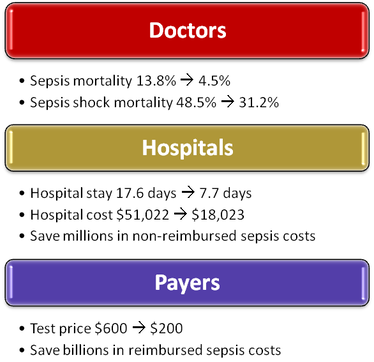
|
Guanine's multi-analyte multi-omics sensor Guanine's sensor quantifies low concentrations by binding targets to a microparticle conjugated with millions of electroactive polyGuanine oligonucleotides. Detection targets can include nucleic acids, proteins, small molecules, cells and redox materials. |
|
Guanine's disruptive platform enables mobile syndromic testing at a fraction of the price of optical technologies
|
|
|
Guanine's low cost quantitative mobile data can be a game changer for using AI to diagnose and treat complex illnesses
|
|
Guanine's technology challenges the status quo
Guanine's upcoming syndromic test will quantify 32 sepsis-causing pathogens and drug resistance biomarkers, and determine antibiotic dose in 1 hour |
|
Sepsis detection and treatment at admission reduces hospital stays, healthcare costs and mortality to benefit doctors, hospitals and payers |
|
Guanine’s products can be adapted for many lucrative market applications
|
|
Guanine's patented detection tag changes biodetection from optical to electrical Electrochemically detectable oligonucleotide tags (EC-DOTs) rich in guanine, provide a new generation of nucleic acid, protein and small molecule assays. Targets are bound to microparticles conjugated with millions of EC-DOTs. When voltage is applied a burst of electrons produces an oxidation peak proportional to the target’s concentration. This allows fast and accurate quantification. Tests include:
|
Guanine has been incubated at the Mount Sinai Health System. Our predecessor company was a spin-off from NASA's Ames Research Center that commercialized NASA’s electrochemical nanosensor for detecting waterborne pathogens.














